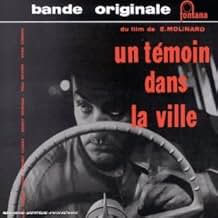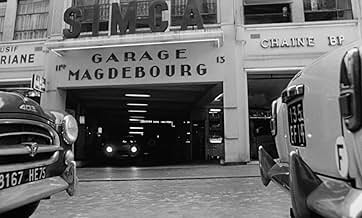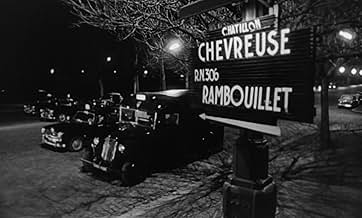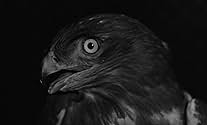IMDb-BEWERTUNG
6,9/10
1022
IHRE BEWERTUNG
Füge eine Handlung in deiner Sprache hinzuSeeking vengeance on his wife's former lover and assassin, a man sets in motion a string of killings.Seeking vengeance on his wife's former lover and assassin, a man sets in motion a string of killings.Seeking vengeance on his wife's former lover and assassin, a man sets in motion a string of killings.
Franco Fabrizi
- Lambert - le radio-taxi de nuit
- (as Franco Fabrizzi)
Martine Messager
- Une standardiste
- (as Martine Reichenbach)
Empfohlene Bewertungen
'Un témoin dans la ville', the third feature film made in 1959 by Édouard Molinaro, begins with a scene of a murder on a train that seems taken from an Alfred Hitchcock film and ends with an anthological and original scene. Between them, in an hour and a half, we are watching one of the best French noir films and the film that launched and consolidated the character of the lone criminal, embodied by Lino Ventura here and in several other films, a character that would also be taken over by other actors and directors (French or not), some among the best.
The original script belongs to the couple of writers Boileau - Narcejac, the very successful authors of the novels of the 'noir' genre in France. Many of their books have been adapted to screens (including by Hitchcock), but here they themselves wrote the screenplay together with Gérard Oury. Ancelin, the main hero of the film commits a premeditated murder. If there are justified crimes, this would be one of them, because the victim is the one who had killed Ancelin's wife and then escaped the legal consequences because of the 'benefit of the doubt'. The crime, however, has a witness, a taxi driver who had been called by the victim a few minutes before he was killed. Ancelin doesn't know what to do. He knows that he risks going to prison for the rest of his life or maybe even to the scaffold, but he is not a born criminal and is not capable of deciding to eliminate the witness. In fact, we do not see Ancelin commit a second murder in the film. The hunter becomes the pray, as the cab driver fraternity rallies to protect their threatened colleague. The film becomes the story of an ordinary man's slide into crime and death.
That in many other cases, the quality of the film resides in the ambiguity. Ancelin is guilty of a morally 'excusable' crime (he avenges his wife and takes out her murderer who escaped justice) and it is not clear whether he intended to commit other crimes or perhaps just convince the witness to keep quiet. Everything is filmed in a Paris at night, in constant motion. Radio taxis seem to predict today's super-connected world, and scenes from the lives of taxi drivers, with the love story between taxi driver Lambert and dispatcher Liliane provide a counterpoint to the dark plot of Ancelin's revenge. Édouard Molinaro is a contemporary of the New Wave and uses some of its inventions (the mobile camera, long shots interspersed with short ones and nervously edited, Paris as a background for love stories or crimes). But he was a director who had the audience in mind, and not himself, like the masters of the New Wave. In a few years he would direct some of the best comedies with Louis de Funès. The jazz-style soundtrack belongs to Barney Wilen, and the cinematography to Henri Decaë, who would also film the masterpiece of the 'lone criminal' genre - Henri Melville's 'Le Samouraï'. Last but not least, we have to talk about Lino Ventura - the actor who carries the film on his shoulders, in the first of his great roles as a lonely hero - positive, negative or ambiguous. I invite you to watch or re-watch the film to decide which category Ancelin belongs to. It will be a satisfying viewing.
The original script belongs to the couple of writers Boileau - Narcejac, the very successful authors of the novels of the 'noir' genre in France. Many of their books have been adapted to screens (including by Hitchcock), but here they themselves wrote the screenplay together with Gérard Oury. Ancelin, the main hero of the film commits a premeditated murder. If there are justified crimes, this would be one of them, because the victim is the one who had killed Ancelin's wife and then escaped the legal consequences because of the 'benefit of the doubt'. The crime, however, has a witness, a taxi driver who had been called by the victim a few minutes before he was killed. Ancelin doesn't know what to do. He knows that he risks going to prison for the rest of his life or maybe even to the scaffold, but he is not a born criminal and is not capable of deciding to eliminate the witness. In fact, we do not see Ancelin commit a second murder in the film. The hunter becomes the pray, as the cab driver fraternity rallies to protect their threatened colleague. The film becomes the story of an ordinary man's slide into crime and death.
That in many other cases, the quality of the film resides in the ambiguity. Ancelin is guilty of a morally 'excusable' crime (he avenges his wife and takes out her murderer who escaped justice) and it is not clear whether he intended to commit other crimes or perhaps just convince the witness to keep quiet. Everything is filmed in a Paris at night, in constant motion. Radio taxis seem to predict today's super-connected world, and scenes from the lives of taxi drivers, with the love story between taxi driver Lambert and dispatcher Liliane provide a counterpoint to the dark plot of Ancelin's revenge. Édouard Molinaro is a contemporary of the New Wave and uses some of its inventions (the mobile camera, long shots interspersed with short ones and nervously edited, Paris as a background for love stories or crimes). But he was a director who had the audience in mind, and not himself, like the masters of the New Wave. In a few years he would direct some of the best comedies with Louis de Funès. The jazz-style soundtrack belongs to Barney Wilen, and the cinematography to Henri Decaë, who would also film the masterpiece of the 'lone criminal' genre - Henri Melville's 'Le Samouraï'. Last but not least, we have to talk about Lino Ventura - the actor who carries the film on his shoulders, in the first of his great roles as a lonely hero - positive, negative or ambiguous. I invite you to watch or re-watch the film to decide which category Ancelin belongs to. It will be a satisfying viewing.
Excellent, very entertaining cat-and-mouse thriller, as an avenging husband (the incomparable Lino Ventura) tries to kill a witness to a murder. In its spare monochrome Decae photography, cool jazz soundtrack, nocturnal settings, focus on elaborate plot mechanics, and privileging of an unlovely outsider, the film is reminiscent of Melville. The 'villain' is only responding to a vicious circle of transgression and injustice, and his plight becomes an allegory for the lonely outsider locked out of a conformist society. The rigorous purity of Melville's aesthetic is softened by romance and comedy, but these only intensify the sense of impending tragedy.
This is really a minor work,but which retains a certain passé charm.The main asset of the movie is Henri Decae's cinematography ,as dazzling as usual.All the night scenes are impressive,the taxis gathering for the chase,the zoological garden with its nocturnal birds ,watching the fighting between the two men.
The screenplay is somewhat disappointing,coming for two writers of Boileau-Narcejac calibre(Vertigo,les diaboliques).There are few surprises,unexpected twists,the Boileau-Narcejac trademarks .The very first scene shows Hitchcock's influence ("shadow of a doubt").Lino Ventura is cast against type because he rarely plays the villains.
Perhaps which is to Molinaro's credit is his depiction of the taxi drivers.From their breakfast at dawn in the bistros where they enjoy coffee and croissants to the rooms where the operators send their messages to the drivers,these are charming vignettes of old Paris at the beginning of general De Gaulle mandate.
Edouard Molinaro's best film remains "la mort de Belle"(1963).His career is essentially commercial,the likes of "la cage aux folles" and "l'emmerdeur" (which was to become Billy Wilder's "buddy buddy").
The screenplay is somewhat disappointing,coming for two writers of Boileau-Narcejac calibre(Vertigo,les diaboliques).There are few surprises,unexpected twists,the Boileau-Narcejac trademarks .The very first scene shows Hitchcock's influence ("shadow of a doubt").Lino Ventura is cast against type because he rarely plays the villains.
Perhaps which is to Molinaro's credit is his depiction of the taxi drivers.From their breakfast at dawn in the bistros where they enjoy coffee and croissants to the rooms where the operators send their messages to the drivers,these are charming vignettes of old Paris at the beginning of general De Gaulle mandate.
Edouard Molinaro's best film remains "la mort de Belle"(1963).His career is essentially commercial,the likes of "la cage aux folles" and "l'emmerdeur" (which was to become Billy Wilder's "buddy buddy").
When he found out his gun had no bullets the killer showed him they were in his hand and asked him to hand over the empty gun, he just concurred without any resistance. I don't think a guy like him in that situation would not try to desperately fight for his life, but instead, he just stood there like a moron, trying to explain and begging for mercy. The killer stood sideways to this guy without any concern if the guy would have tried to fight for his life, he just slowly put the bullets back into the chamber. This ridiculous scene and scenario could only happen in a badly scripted screenplay not in a realistic world. When I watched this absurd scene, I had to quit watching to avoid brain damage.
While leaving the scene of his crime, a murderer encounters a cab driver who will be able to identify him. For the rest of the film, the killer hunts down the driver, who becomes a character in the story.
No spoilers for this one, with terrific driving sequences and chases in night-time Paris and some colorful characters. Ventura--who must act without much dialog--is very good, as are Franco Fabrizzi and Sandra Milo (both of whom appear significantly in Fellini films)
No spoilers for this one, with terrific driving sequences and chases in night-time Paris and some colorful characters. Ventura--who must act without much dialog--is very good, as are Franco Fabrizzi and Sandra Milo (both of whom appear significantly in Fellini films)
Wusstest du schon
- WissenswertesFilmed with the co-operation of the 400 radio taxi drivers of Paris.
- VerbindungenReferenced in Das süße Leben (1960)
- SoundtracksTémoin Dans La Ville
Written by Barney Wilen
Performed by Barney Wilen, Kenny Clarke, Kenny Dorham, Paul Rovère and Duke Jordan (as Barney Wilen Quintet)
Top-Auswahl
Melde dich zum Bewerten an und greife auf die Watchlist für personalisierte Empfehlungen zu.
- How long is Witness in the City?Powered by Alexa
Details
- Erscheinungsdatum
- Herkunftsländer
- Sprachen
- Auch bekannt als
- Witness in the City
- Drehorte
- Jardin d'acclimatation, Bois de Boulogne, Paris 16, Paris, Frankreich(Ancelin flees into zoo)
- Produktionsfirmen
- Weitere beteiligte Unternehmen bei IMDbPro anzeigen
- Laufzeit1 Stunde 29 Minuten
- Farbe
- Sound-Mix
- Seitenverhältnis
- 1.66 : 1
Zu dieser Seite beitragen
Bearbeitung vorschlagen oder fehlenden Inhalt hinzufügen

Oberste Lücke
By what name was Der Mörder kam um Mitternacht (1959) officially released in Canada in English?
Antwort





























